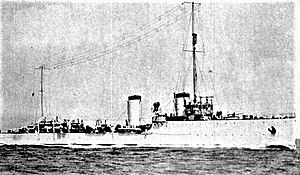Mirabello-class destroyer
This article includes a list of references, but its sources remain unclear because it has insufficient inline citations. (January 2013) (Learn how and when to remove this template message) |
 | |
| Class overview | |
|---|---|
| Builders: | Ansaldo, Genoa |
| Operators: | |
| Built: | 1914–1917 |
In commission: | 1917–1951 |
| Planned: | 3 |
| Completed: | 3 |
| Lost: | 2 |
| Retired: | 1 |
| General characteristics | |
| Type: | Destroyer |
| Displacement: |
|
| Length: | 103.75 m (340 ft 5 in) |
| Beam: | 9.75 m (32 ft 0 in) |
| Draught: | 3.2 m (10 ft 6 in) |
| Propulsion: |
|
| Speed: | 35 knots (65 km/h; 40 mph) |
| Range: | 2,840 nmi (5,260 km) at 15 knots (28 km/h; 17 mph) |
| Complement: | 158 |
| Armament: |
|
The Mirabello class were a group of 3 destroyers built for the Regia Marina during World War I.
The ships were designed as scout cruisers (esploratori), essentially enlarged versions of contemporary destroyers. All ships were built by Ansaldo in Genoa. Three ships were built but one was lost to a mine in the Black Sea in 1920, during the Allied intervention in the Russian Civil War. The remaining two ships, obsolescent by 1938, were re-rated as destroyers and fought in World War II. Riboty was reconfigured as a convoy escort. The torpedo tubes were removed and depth charges and 20 mm (0.79 in) anti-aircraft guns added.
Ships
| Ship | Laid Down[1] | Launched[1] | Completed[1] | Fate/Service |
|---|---|---|---|---|
Carlo Mirabello | 21 November 1914 | 21 December 1915 | 24 August 1916 | Sunk 21 May 1941 by mines near Cape Dukato, Albania |
Carlo Alberto Racchia | 10 December 1914 | 2 June 1916 | 21 December 1916 | Sunk by mine 21 June 1920 in the Black Sea |
Augusto Riboty | 27 February 1915 | 24 September 1916 | 5 May 1917 | Allocated to USSR as war reparation; scrapped in 1951 |
References
^ abc Gardiner and Gray 1985, p. 265.
Fraccaroli, Aldo (1970). Italian Warships of World War 1. London: Ian Allan. ISBN 0-7110-0105-7..mw-parser-output cite.citation{font-style:inherit}.mw-parser-output .citation q{quotes:"""""""'""'"}.mw-parser-output .citation .cs1-lock-free a{background:url("//upload.wikimedia.org/wikipedia/commons/thumb/6/65/Lock-green.svg/9px-Lock-green.svg.png")no-repeat;background-position:right .1em center}.mw-parser-output .citation .cs1-lock-limited a,.mw-parser-output .citation .cs1-lock-registration a{background:url("//upload.wikimedia.org/wikipedia/commons/thumb/d/d6/Lock-gray-alt-2.svg/9px-Lock-gray-alt-2.svg.png")no-repeat;background-position:right .1em center}.mw-parser-output .citation .cs1-lock-subscription a{background:url("//upload.wikimedia.org/wikipedia/commons/thumb/a/aa/Lock-red-alt-2.svg/9px-Lock-red-alt-2.svg.png")no-repeat;background-position:right .1em center}.mw-parser-output .cs1-subscription,.mw-parser-output .cs1-registration{color:#555}.mw-parser-output .cs1-subscription span,.mw-parser-output .cs1-registration span{border-bottom:1px dotted;cursor:help}.mw-parser-output .cs1-ws-icon a{background:url("//upload.wikimedia.org/wikipedia/commons/thumb/4/4c/Wikisource-logo.svg/12px-Wikisource-logo.svg.png")no-repeat;background-position:right .1em center}.mw-parser-output code.cs1-code{color:inherit;background:inherit;border:inherit;padding:inherit}.mw-parser-output .cs1-hidden-error{display:none;font-size:100%}.mw-parser-output .cs1-visible-error{font-size:100%}.mw-parser-output .cs1-maint{display:none;color:#33aa33;margin-left:0.3em}.mw-parser-output .cs1-subscription,.mw-parser-output .cs1-registration,.mw-parser-output .cs1-format{font-size:95%}.mw-parser-output .cs1-kern-left,.mw-parser-output .cs1-kern-wl-left{padding-left:0.2em}.mw-parser-output .cs1-kern-right,.mw-parser-output .cs1-kern-wl-right{padding-right:0.2em}
Gardiner, Robert; Gray, Randal (1985). Conway's All The World's Fighting Ships 1906–1921. London: Conway Maritime Press. ISBN 0-85177-245-5.
Whitley, M.J. (2000). Destroyers of World War 2. Cassell Publishing. ISBN 1-85409-521-8.
